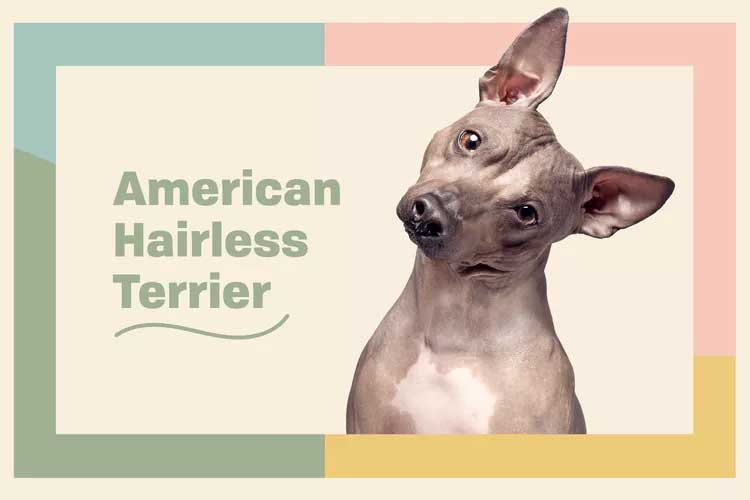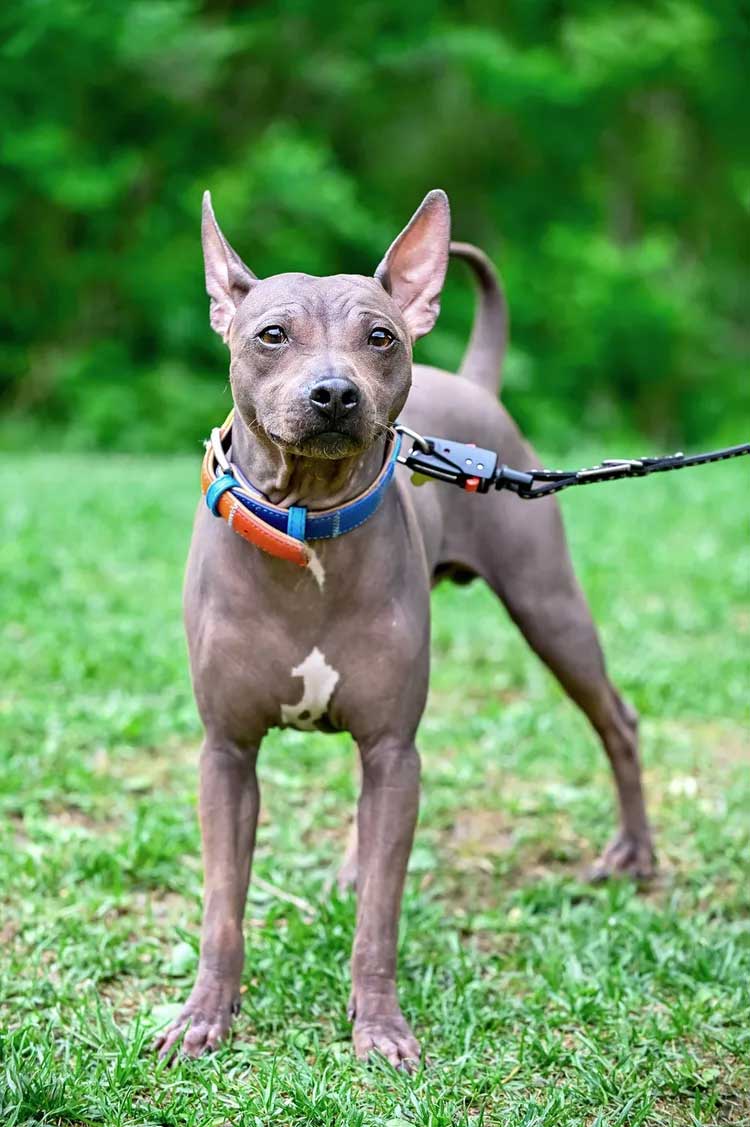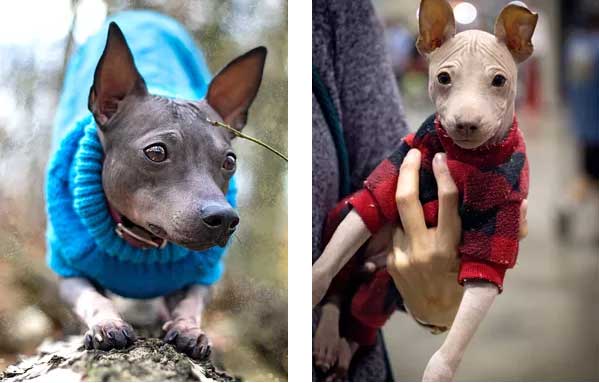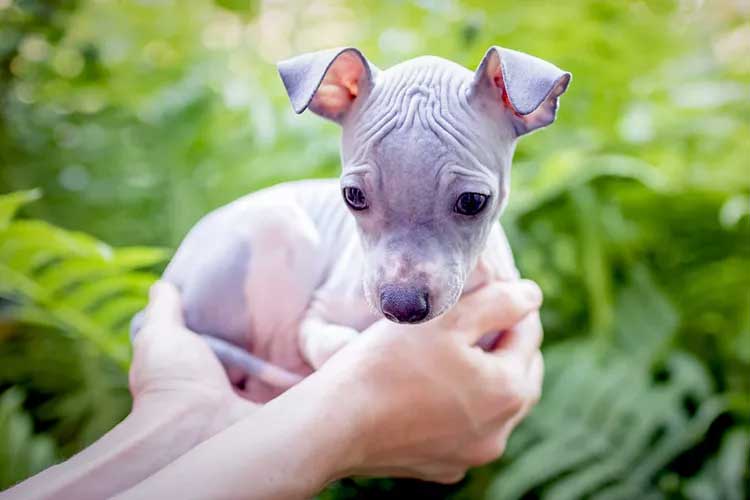American hairless terriers are a lively, courageous, and loyal breed that descended from the rat terrier. Learn more about living with this rare hairless breed.

American Hairless Terrier Overview
| OFFICIAL NAME | American Hairless Terrier |
| COMMON NAME | American Hairless Terrier |
| PET HEIGHT | 12 to 16 inches |
| PET WEIGHT | 12 to 16 pounds |
| LIFESPAN | 14 to 16 years |
| GOOD WITH | children, dogs, families, seniors |
| TEMPERAMENT | friendly, outgoing, playful |
| INTELLIGENCE | high |
| SHEDDING AMOUNT | infrequent |
| EXERCISE NEEDS | medium |
| ENERGY LEVEL | active |
| VOCAL LEVEL | when necessary |
| DROOL AMOUNT | low |
| BREED GROUP | terrier |
| BREED SIZE | small (0-25 lbs.) |
| COAT LENGTH | hairless |
| COLORS | black, blue, brown / chocolate / liver, red, white |
| PATTERNS | bicolor, black and tan, blue and tan, brindle, flecked / ticked / speckled, sable, tricolor |
| OTHER TRAITS | apartment-friendly, easy to groom, easy to train, high potential for weight gain, high prey drive, hot weather tolerant, hypoallergenic, prone to health issues, strong loyalty tendencies |
If you're lucky enough to meet the rare American hairless terrier, you can expect to be welcomed with a pawsitively playful energy. These fun-loving pups, sometimes known as the hairless rat terrier, can be best described as spunky little balls of cheerful, curious, and upbeat energy.
Although there is no such thing as a 100-percent hypoallergenic dog, the American hairless terrier can be a great choice for allergy sufferers. The only hair you'll find on them is their eyebrows and whiskers, so shedding is minimal (if anything at all).
Though, there are some varieties of the American hairless terrier that are not completely hairless. In these cases, the pups (referred to as coated American hairless terriers) have very fine, short, and thin fur. But because their coats are so thin, even the coated American hairless terrier can still be a good match for those with allergies (although hair is not the sole cause of pet allergies).
Appearance
This breed's primary distinguishing factor is in her name: hairless."The American hairless terrier has an anomaly called a follicular dysplasia," says Stacy Choczynski Johnson, DVM, veterinarian at Pumpkin Pet Insurance. "In their breed, their baldness is considered normal! Follicular dysplasia is a hereditary abnormality of the hair follicle that does not have any inflammation associated with it. It only causes the hair to shed. With American hairless terrier dysplasia, a genetic mutation causes the thin puppy coat to shed after a month of age and never regrow. Only the whiskers and eyebrows will remain, giving this terrier its classic look."

When you initially imagine a hairless dog, you might picture a dog with light pink skin. However, American hairless terriers have pigmentation that can vary greatly. This breed can be black, white, grey, blue, red, or brown, and they can be born one solid color or a combination of two or three.
Standing at just 12–16 inches tall and weighing under 16 pounds, the hairless terrier has a small yet well-muscled stature. Their triangular ears typically stand upright, though sometimes the tips neatly fold over. Their tail is tapered and rests in a slight curve—and always wags when they see their favorite human.
Temperament
American hairless terriers have the trademark terrier attitude. Descendants of the rat terrier, who was originally bred to hunt small vermin, the American hairless terrier carries on that courageous, bold, and loyal spirit.They are active dogs that love playtime with children and other pups. But because they have a high prey drive thanks to their hunting history, they may not play well with cats or other small animals. However, if American hairless terrier puppies are socialized with other small animals when they are young, becoming friends with cats and other pets isn't entirely out of the question.
Many people assume that small dogs are natural lapdogs—and while the hairless terrier loves a good cuddle, that doesn't mean they would prefer to lounge on the couch all day over a trip to the dog park. The American hairless terrier likes to keep her paws moving, and she'll require daily walks and adequate playtime to expend all her energy.

As intelligent, curious, and lively dogs, they certainly won't be happy cooped up all day alone. Be sure to provide your American hairless terrier with proper exercise and attention, and you'll have a loyal friend by your side at all times—and never have a dull moment.
Living Needs
Because American hairless terriers are so small, they are fairly adaptable and do well in apartments and with city life. But this doesn't mean they'll be happy spending all day every day inside.Hairless terriers thrive with daily walks and need around 30 minutes of physical activity every day. She'll especially love a trip to the park to burn off her energy! But if you can't play outside in a fenced yard or a park, that's OK—playtime indoors makes her happy, too. As long as you give her plenty of mental stimulation and exercise, her tail will stay wagging.
American hairless terriers are not happy being alone for long periods of time. They may be able to stay home alone for four to six hours per day, but any longer and separation anxiety might start to set in. These little dogs want to be near people, so if you're away from home for a long time, plan for a dog walker or pet sitter to come by during the day.
Care
While you obviously won't need to worry about weekly brushings or scheduling haircuts at the groomer, the American hairless terrier isn't completely maintenance-free. She requires the occasional bath, regular nail trims, and ear cleanings.One of the most important aspects of caring for American hairless terriers and other hairless breeds is protecting their skin.
"As they have no fur, they are prone to sunburn and hypothermia," says Linda Simon, MVB, MRCVS, consulting veterinarian at FiveBarks. "Owners need to regulate their temperature closely and keep them out of direct sunlight. They have less protection when in the great outdoors [and] shouldn't be allowed to do things like run through brambles, as they could get some nasty injuries."

So if you plan a long walk, summer hike, or day at the beach with your American hairless terrier, remember to apply (and re-apply!) veterinarian-approved sunscreen. Basically, you'll want to put sunscreen on these pups if they'll be outside longer than 15 minutes. And if you are out and about in intense heat, make sure your pup always has access to shade—even if it's just under an umbrella.
During the snowy months, you still need to take precautions. Your hairless terrier will need a well-fitting, durable winter coat for walks outside. She may even need a sweater indoors to stay cozy and be protected from any drafty windows. You'll also need to make sure her skin isn't becoming too dry with a veterinarian-approved lotion.
Health
American hairless terriers have a long life of 14–16 years, but there are a number of health issues pet parents will need to look out for."As this breed originated from a shallow gene pool, it isn't a surprise that they suffer from several medical issues," Simon says. She says American hairless terriers can develop:
Patellar luxation: A common condition in small dog breeds where the knee joint slips out of place. There is little that can be done to prevent patellar luxation, but by keeping an eye out on warning signs, such as licking at the knee, limping, or an unwillingness to walk, you may be able to treat the issue before it becomes more severe and surgery is required.
Skin conditions: Atopic dermatitis and other skin conditions like demodectic mange are other conditions to be aware of, especially because the American hairless terrier's skin is completely exposed. Keeping your hairless terrier clean can prevent any skin conditions from arising. For example, if you're out exploring the great outdoors with your pup, keep an eye out for thorny plants, bushes, and other vegetation that could cause scratches or irritation.
Diabetes and obesity: This can also be prevented with a high-quality, healthy, and portion-controlled diet. Regular exercise is also critical for your pup's health. Because American hairless terriers are so small, even gaining just a pound or two can have a major impact on their health. It's a good idea to monitor your terrier's weight and bring up any changes with your veterinarian.
Cushing's disease: A type of hyperadrenocorticism caused by a tumor in the pituitary gland that produces adrenocorticotropic hormone (ACTH). Signs of Cushing's disease can be heat intolerance, lethargy, muscle weakness, panting, and recurring urinary tract infections, among other symptoms.
History
The American hairless terrier is the only hairless dog breed indigenous to the United States. They are actually a naturally occurring descendant of the rat terrier—some would say a "happy accident."
"The American hairless terrier is characteristically bald and has only been in existence for about half a century," Simon says. "They were bred from the rat terrier and have a similar conformation and appearance—apart from the lack of fur, of course! They are quite a rare dog and many people have never seen one."
Simon says the first American hairless terrier, named Josephine, was born to a litter of rat terrier puppies in 1972 Louisiana. The breeders were a family called the Scotts and they bred her many times in the hope of producing bald litters.
"Ultimately, she only ever produced three hairless pups," Simon says. "While one was in her first litter, the remaining two didn't make an appearance until her ninth." This was the beginning of the American hairless terrier breed.
Originally, these hairless pups were simply known as a hairless variety of the rat terrier. It wasn't until 2016 that the American Kennel Club officially recognized the American hairless terrier as a breed.
Fun Facts
The American hairless terrier is the only hairless dog breed native to the U.S.Given how rare this breed is, the American hairless terrier price range can be pretty steep. Some purebred American hairless terrier puppies can cost between $800 to $1,800.